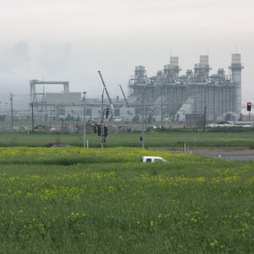California is the lab rat in the cap & trade maze

One day after the midterm congressional elections, President Obama was already talking about cap & trade in the past tense: “Cap & trade was just one way of skinning the cat. It’s not the only way,” the President told reporters. “It was a means, not an end. And I’m gonna be looking for other means to address this problem. Senator Joe Lieberman put it more bluntly. “Cap and trade is off the table,” Lieberman said. “We have to start on the presumption that the table is clean, that nothing is on it.”
But while Washington is “looking for other means” to reduce the carbon emissions that cause global warming, the table is set for cap & trade in California. By day’s end Thursday, the state will likely have the nation’s first system that covers more than electric utilities.
If the California Air Resources Board formally adopts a set of proposed regulations from its staff, as expected, then starting in early 2012, major emitters of greenhouse gases will come under the program. That ‘s anything that puts out more than 25,000 tonnes of C02 per year; we’re talking power plants, cement kilns, glass factories and of course, oil refineries, where carbon emissions are measured in the millions of metric tons per year.
In 2015 the program will expand and follow these oil and gas products downstream; that means producers will have to account–and eventually pay for–not just the emissions from drilling and refining, but for that carbon produced when the fuel actually gets burned in trains and planes and automobiles.
I say “eventually” because the pay-to-play part doesn’t really kick in right away. At first, the state will give away 90% of emissions permits. That will help ease the transition for industry and, in theory, keep companies from fleeing California.
Jamie Fine, a policy watcher with the Environmental Defense Fund in Sacramento, figures that by 2015, more than half the carbon permits will be auctioned off.
That will mean billions of dollars in permit revenues funneled through Sacramento — estimates are at least $7 billion a year — maybe double that. And what we still won’t know, exactly, even after today’s vote, is what the state will do with all that money. Fine says that will likely fall to lawmakers to decide. In a recent Field poll, more than half the respondents favored using the cash to shore up the state budget.
More likely — and more desirable, says Fine — is a system, where the proceeds find their way into households and businesses through tax breaks, utility rebates, or incentives to make energy upgrades.
Even with all that loot looming, Washington and most states are watching from the sidelines, to see how this plays out. Once again, California is the lab rat in the cap & trade maze. From his vantage point inside the Washington beltway, at the think tank Resources for the Future, economist Richard Morgenstern says the world is watching California with cautious approval. “They’re saying California has adopted a basically sensible policy,” says Morgenstern, who has modeled the proposed carbon trading system and its likely impact on the economy (minor, he says). “They are clearly mindful of the economic and political downsides. California has a good record of experimenting in the environmental field and I suspect this will be successful.”
Some business groups remain skeptical. Michael Shaw, who helps run the California branch of the National Federation of Independent Business, says he’s still concerned about the “general ignorance” of how cap & trade could hurt small businesses by pushing up prices for fuel, electricity and other commodities.
While carbon trading has been the subject of both hope and derision, it may be getting more than its share of attention in the attack on carbon. It’s just one component of California’s climate strategy under AB 32. The state is hoping to get about 20% of its greenhouse gas reductions through cap & trade.
